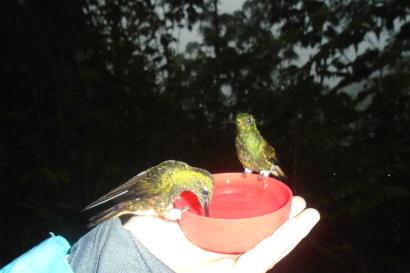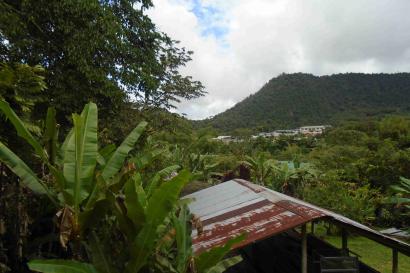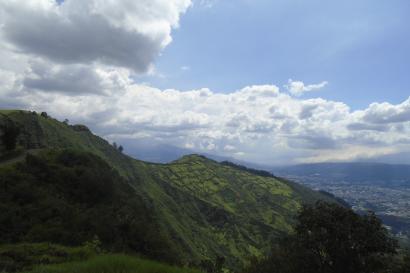From the balcony of my room in Tumbaco, Ecuador, I can look west and see the city of Quito nestled snugly in the shadow of Volcán Pichincha. The mountain’s peak gets lost in the clouds and haze during the heat of the day, but when that heat breaks at dusk it sits blue-gray against a naranjilla colored sky. Many of the foreign students studying here in Quito (myself included) are not used to volcanos on the horizon– and while we may not be able to feel the subduction of the pacific plate under the South American continent, we can see it. On a boat ride around Lago de Cuicocha in Imbabura Province (about 2 hours north of Quito), we watched bubbles of gas escaping from the lakebed and fizzing at the surface: the water-filled crater of this once active volcano is waking up again. While the droves of Slate-colored Coots paddling the lake seemed ambivalent to the threat, we all shared some nervous glances. Over lunch earlier in the day, one student had looked up at the cloud-capped peak of Volcán Imbabura and said, almost in awe, “does it still blow your mind that we’re surrounded by active volcanoes everyday?”
It does blow my mind, honestly. On my first day, and today as well. It blows my mind that the earth is moving beneath us, forcing up mountains and opening up pockets for its insides to spill out. It blows my mind that we can watch it, see the bubbles burst at the surface, feel a deep time that has crafted these canyons, peaks and valleys and will mold them into something new long after we’re gone. It blows my mind that here, in the Andes, the violence of a fault in conflict has crafted one of the most biodiverse places on earth, as if the stirring of the surface has mixed and mismatched the very ingredients of life itself– evolution heated from beneath. Biology and geology students, shake hands. We can get excited about this together.
While I have so far spent most of my time in and around Quito itself (that will change soon) I have been exploring that world-class biodiversity as much as I can. The Chaquiñán, as its called here, is a 20 km long walking-biking trail that runs just behind my host family’s house in Tumbaco with a western terminus quite near the USFQ campus in Cumbaya. The trail has become a familiar stomping ground for me already, and if I get a pocket of free time at home I’ll wave my host family goodbye (“estoy caminando en el Chaquiñán!) and thread my way down the alleyway with the “karate” sign on it until I reach the thickets of vegetation that mark the riparian corridor and my access to the trail. No matter the time of day, there are always people out and about– children on their bikes, elderly friends out for a stroll, joggers leading a pack of dogs– and they all wave and say hello (well, except the joggers). While the trail buts up against backyards and gated neighborhoods, small parks and manicured hedgerows (little “natural” habitat) I’ve found it to be a wonderful introduction to the truly local birdlife of the area. Sparkling Violetears, large emerald green hummingbirds with violet bellies and earmuffs, buzz between drooping flowers with voracious energy, bold and inquisitive among the throngs of people. An Azara’s Spinetail pops up from within a thicket just long enough for me to catch a glimpse of its handsome rufous-and-gray plumage between the leaves– it maintains its secrecy despite the species’ relative abundance. Ruby-red Vermillion Flycatchers sally out from dead snags and wires along the route to take any flying insect from their airspace; I salute them. It’s also really cool to see neotropical migrants on their wintering grounds, birds I’m familiar with from summers back home who are spending the winter down south. The Summer Tanagers and Swainson’s Thrushes I’ve seen in the scrubby woodland along the Chaquiñán are a long way from the forests of the Eastern US, but I always wonder whether these are individuals I’ve encountered before. There’s no way to know, of course, and the odds are exceedingly slim, but the thought reminds me of my place in all this. It makes me think about the connections between here and home, and what they mean.
Of course, a huge part of my experience here in Ecuador so far has been the people I’ve shared it with. This includes both my fellow students and my wonderful host family, who’ve made Ecuador feel like a home with their generosity and high-spirits (teasing about my bad Spanish requires no translation). Their diligent explanations of public transit and willingness to get up early to drive me to campus for an early morning field trip or two is a kindness I’m finding difficult to repay, and even though I offer my help with dinner and dishes every night I am always turned away. This seems like a common testimony from most of the students here: generosity and hospitality run deep, and we have been the grateful beneficiaries. The food, I have to say, has been simply incredible. I wasn’t all that familiar with Ecuadorian cuisine before arriving here, but now there’s no going back. I am struggling to keep up with the names of all the fruits included in our daily diet (whether sliced, diced, or in smoothies/juices) while the various ceviches, ahis (hot sauces) and salads I’ve been eating alongside the ubiquitous chicken, rice, beans and potatoes have been absolutely phenomenal. I know the selection of fruits available in Quito, at a regional crossroads, is a lot more diverse than in the Galapagos, so I’m trying to fill up now before we ship out across the sea. Just tonight I had the most wonderful fresh blackberry (mora) juice my host mother made and strained before dinner– I told her it was my favorite juice so far, but to be honest they’ve all been too good to parse out.
So, yeah– my time in Ecuador is off to a pretty great start. I have too much to say, and will have to save some for later.
Til then,
Ciao.
-Brendan

Brendan Murtha
<p>Hi everyone! My name is Brendan, and I'm a junior at Bowdoin College (Brunswick, ME) studying Ecology, Evolution, and Marine Biology. I'm passionate and curious about all things natural history related, and although my main focus has always been birds, I am just as likely to be found photographing dragonflies or catching snakes as I am craning my neck to look at the skies. These interests have also led me down paths of human ecology, conservation, and all things political, and I enjoy exploring such topics in my writing, photography, and music. I'm super excited to be part of the GAIAS program this semester, and hope to capture some of the magic through my posts.</p>








